
The appeal of exchange-traded funds (ETFs) is clear: increase the diversification of your portfolio by targeting a large basket of equities with a single ticker to trade, and leave oversight of that basket to professional fund managers. It's no wonder that ETFs have ballooned in popularity, now comprising more than 10,000 funds managing over $11 trillion in assets.
A trade-off to ETFs for retail investors is that fund managers charge a fee to oversee and administer these products. While an expense ratio may not seem like a significant amount of money—a ratio of 0.50% means you'll pay $50 on every $10,000 invested in an ETF each year—these fees have the potential to add up. That's why, among the many other considerations to keep in mind when selecting an ETF to invest in, the expense ratio is a key factor for investors to consider.
Fortunately for investors, fund providers are often competing against other managers for investor assets, and one way they differentiate their products is by lowering expense ratios to make a more attractive value prospect for potential customers. There are many funds with a relatively low expense ratio which nonetheless provide outsized returns by beating the broader market.
SPMO: Momentum Factor Investing at a Low Cost
The Invesco S&P 500 Momentum ETF (NYSEARCA: SPMO) is focused on S&P 500 stocks that have a recent history of outperformance. By looking at firms that have a strong 1-year history of growth, SPMO aims to give investors a chance to capitalize on continued momentum in fast-growing stocks while mitigating risk through a portfolio of 100 different names. The key to SPMO's methodology is that it excludes performance in the most recent months and adjusts for volatility. This helps to protect against outlier companies that may have experienced a short-lived spike.
As one of a growing number of factor funds, SPMO differentiates itself with a low expense ratio of just 0.13%. Given its 1-year return of nearly 69%, this is a competitive fee and a good value. However, there are other momentum funds that provide broader diversification for investors considering a long-term approach.
FGLD: Access to Responsibly Sourced Gold
The Franklin Responsibly Sourced Gold ETF (NYSEARCA: FGLD) provides investors with indirect access to gold bullion. Gold prices have continued to soar to new record highs throughout 2024, making funds that offer exposure to the gold industry highly desirable. In the last year, FGLD is up 40%, on par with the S&P 500, and it has an expense ratio of just 0.10%.
There are a host of ETFs that offer gold exposure, including to stocks focused on gold mining as well as to bullion itself. FGLD distinguishes itself by only holding responsibly sourced gold, defined as London Good Delivery gold bullion bars that were refined after 2011 and according to ethical and environmental standards to protect against human rights abuse, money laundering, and other negative actions.
SEIM: Another Targeted Momentum Play
Like SPMO above, the SEI Enhanced U.S. Large Cap Momentum Factor ETF (BATS: SEIM) is a momentum factor fund that centers around large-cap stocks. It is an actively managed fund seeking to target companies that have a history of strong performance and, secondarily, attractive value and volatility metrics, among other characteristics.
SEIM has an even narrower list of stocks than SPMO, with only 63 holdings as of late October 2024. However, it's rare for investors to get access to an actively managed fund for an expense ratio of just 0.15%, and the fund's 1-year performance of nearly 53% speaks for itself.
ETF Considerations
Low expense ratios and strong performances make these and similar ETFs attractive prospects for investors searching for a low-lift investment. It's important to note that the expense ratio is just one of many important considerations, though. If you plan to trade your ETF holdings more regularly, it pays to watch a fund's liquidity metrics including trading volume, for example. Lower liquidity may make trading more expensive, reducing or even canceling out the benefit of a low expense ratio. On the other hand, buy-and-hold strategies may be more interested in the diversification of a fund and how often it is rebalanced.














